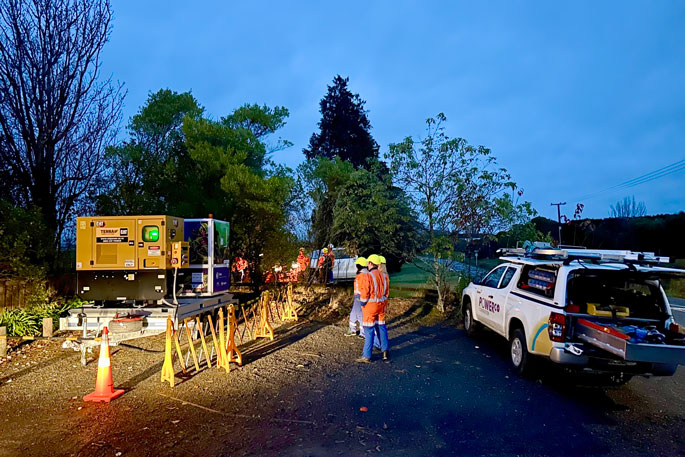Mobile stand-alone power systems featuring eye-catching native flora and fauna designs, are taking to the roads throughout Powerco’s electricity network to help lower emissions while keeping the power on during some outages.
Four trailer-mounted mobile hybrid SAPS/BESS (battery energy storage system) units, supplied by Base Power, have been wrapped in specially designed artworks by artist Sarah Kolver.
The units have recently been purchased by Powerco to help lower its emissions and reduce diesel use during some outages, Powerco General Manager Electricity Karen Frew says.
"When a fault occurs on our network, if power can’t be restored within a specific timeframe and other practical outage mitigation options, such as network back feeds, are not available, we consider using a diesel generator as an interim power supply.
"Depending on the fault, diesel generators may need to be connected for a number of days, until repairs are completed.
"Generator-hybrid BESS solutions like these units ensure an efficient, quiet, and sustainable power supply by optimising fuel consumption and reducing emissions.
"Onsite, when the battery has been fully used, the generator kicks in and recharges the battery. Back at the depot, the batteries are recharged before the next deployment by using the grid. Using them means we can substantially lower our emissions overall."
The mobile hybrid SAPS system combines a 60kWh battery unit with a standard diesel generator.
The 20kVA three-phase capacity of the units is suitable for residential houses and small commercial customers, such as play centres.
Using the 60kWh battery units alongside the generator may reduce up to 80% of diesel used during a typical outage.
Along with its service provider Downer, Powerco recently used one of the units to power an early childhood centre in Paengaroa in Western Bay of Plenty, during a planned outage to replace and upgrade crossarms, poles and power lines along a 3km stretch of Black Rd.
On the day of the outage, the battery was taken to site, connected and monitored throughout. It used an average of 2% battery capacity per hour.
At the completion of the outage, the centre had only used 20% of the capacity of the battery and no back-up diesel generation was required.
Typically, on an outage such as this, a diesel generator may use 40 litres of diesel (at 75% load).
Within 48 hours of that outage, Downer again deployed a unit on behalf of Powerco to a fault affecting two homes in Papamoa (see installation in the photo below).
The houses used an average of 2.8% battery capacity per hour. At the completion of the outage, the houses used 92% of the capacity of the battery. Back-up generation was used to recharge the battery for 2.5 hours (15 litres of diesel).
Typically, on an outage such as this, a diesel generator may use about 140 litres of diesel (at 75% load). This is a 90% diesel reduction.
Karen says Powerco is committed to helping Aotearoa New Zealand achieve its net-zero by 2050 goal, by enabling the sustainable energy transition.
As part of this, Powerco and its service providers aim to reduce emissions from temporary diesel generators.
"As larger portable battery units become available, we’ll also look at using them for more widespread customer outages or customers with higher electricity loads. The ability to pair with small-scale portable solar panels will also increase the range of uses."
Currently, each battery unit can supply up to three residential customers.
Powerco is New Zealand’s second largest electricity and gas distribution utility with over 900,000 customers (across 457,000 connections) connected to its networks. Powerco’s electricity networks are in Western Bay of Plenty, Thames, Coromandel, Eastern and Southern Waikato, Taranaki, Whanganui, Rangitīkei, Manawatū and the Wairarapa. Its gas pipeline networks are in Taranaki, Hutt Valley, Porirua, Wellington, Horowhenua, Manawatū and Hawke’s Bay.



1 comment
The Master
Posted on 29-07-2024 16:24 | By Ian Stevenson
The above says "mobile hybrid SAPS system combines a 60kWh battery unit with a standard diesel generator." Of course that wonder tech still needs a generator, important point being "diesel..."
You just can not escape the facts here, the Battery needs a fossil fuel means to charge it... what a joke it is.
Let not get into the huge amount of mining (20-200% more required for batteries, the same scenario applies to wind and solar generation and storage. If a simpleton looks at the front end only then all is just so wonderful... but in reality the emissions, mining and all factors generally point to massive increases in mining required, costs and what one would call, to be extremely nice "variable supply and outages" that will all inevitably happen.
The obvious power supply in NZ id Hydro, so where are the new dams?
Leave a Comment
You must be logged in to make a comment.